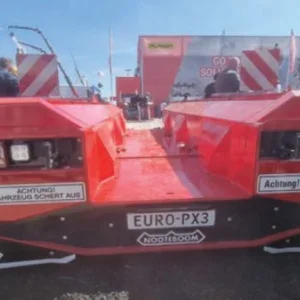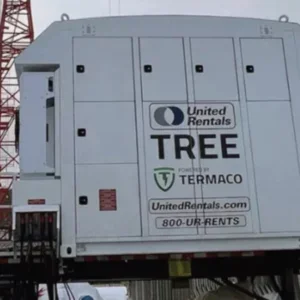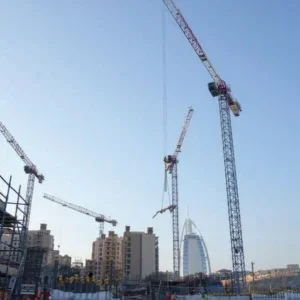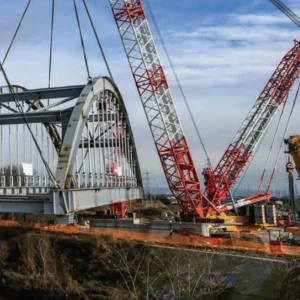With increased demand for construction equipment in almost every end user sector there is a plethora of opportunity for the crane industry, especially on energy, transport and infrastructure projects. And that’s not to mention Brazil hosting the 2014 World Cup and 2016 Olympic Games—those two, they’re just the icing on the cake, says Sobratema, the Brazilian Association of Technology for Equipment and Maintenance.
Between 2006 and 2008, the economy had high growth rates connected to a continuous effort to increase investments through two phases: in mineral resources, and in infrastructure, housing and durable consumer goods. BNDES, Brazil’s main financing bank for long-term investments in industry and infrastructure, called it the nation’s “highest investment cycle in the last 30 years.” In response to the global financial crisis, the bank said in February 2009 that “even facing such a dire outlook the expansion of investments should last.”
Crane manufacturers and dealers in Brazil have enthusiastically responded that 2008 was a very good year, if not the best in some cases. And while they couldn’t say the same about last year, the industry says confidently that 2010 has already seen a better market. Brazil’s Central Bank expects the nation’s GDP to grow by 5.8% this year, after seeing only 0.2% growth last year. Sobratema forecasts the number of tower cranes sold domestically in 2010 will rise a whopping 128% from 2009 levels: when the market dipped last year, just 70 units were sold compared to 130 in 2008.
“It’s expected that Brazil will need at least $86bn in infrastructure investments over the next decade to expand its transportation and energy production,” says Arnold Huerta, the US Association of Equipment Manufacturers’ director of global business development Latin America.
“Last year Brazil was among the top five countries receiving US exports of cranes,” he says. “The construction sector is expected to be the leading employment generator over the next several years, with at least 46% of new jobs anticipated for 2010.”
The pace of PAC
According to BNDES many of the infrastructure investments during 2006 to 2008 that contributed to the economy’s high growth rates were prompted by the government’s Growth Acceleration Program, known by its Portuguese abbreviation as PAC.
President Luis Igacia Lula da Silva introduced the BRL504bn ($257.1bn at historic rates) programme in 2007. Despite the promises of investment in construction work, three years later, there is a mixed response from industry.
Marina Simões of crane and transport rental company Locar says PAC has helped business, and that Locar has had a tower crane building housing in Rio de Janeiro since last year through the programme. But companies not involved in the residential market say that they have seen very little, if any, work from it. Lupercio Torres Neto, director of IRGA, which offers hydraulic truck cranes, conventional and crawler cranes, calls it an illusion: “The business that we are doing, I must say that 80% is outside of PAC.”
The consensus among the crane industry is that the programme is too slow to have a significant effect and that most PAC projects are still on paper.
“Most of the projects that were supposed to start already have been postponed due to government issues, paperwork, sometimes due to environmental impact, and so on,” says Filinto Vargas, sales manager, Terex Cranes Latin America. “Yes, it was good to everybody including the machinery industry, however it wasn’t as fast as everybody was expecting. That’s the main point.”
In March, the Brazilian government announced the programme’s second phase, PAC 2, worth $526bn over four years. These investments include the 2014 World Cup and 2016 Olympic Games, among other projects, many of which will be open to foreign companies.
The federal government’s public housing programme Minha Casa, Minha Vida (My House, My Life) will receive $43bn to build two million homes. That’s outside of the estimated BRL22bn the programme should receive for 2010. And billions of dollars are to be poured into projects for hydroelectric and nuclear plants, railways, shipbuilding and oil production.
PAC 2, again, draws mixed response ranging from optimism to disbelief. With presidential elections looming in October, many have dismissed it as an election ploy. Term-limited President Lula’s former chief of staff, Dilma Rousseff, who resigned in order to be one of the main presidential candidates, has been called an architect of the PAC concept. And the plan had been announced days before she left her post.
The reality is no matter how successfully the government implements the programme, nor the election’s outcome, there is plenty of work to be done in Brazil. Márcio Guimarães de Campos is the director of T.D.B do Brasil, a Tadano dealer and manufacturer of Tadano cranes on Brazilian chassis. He says this is the best time in Brazil for cranes “because everything must be done.”
He uses Japan as an example. Brazil has about 5% of the number of cranes in service compared to Japan, which in landmass, is considerably smaller. There are numerous natural resources available to Brazil, and noone is fully sure what other minerals exist or the full extent of these resources. “In Brazil you have everything to do,” unlike the US where cranes are needed for maintenance or conservation, rather than extensive development, de Campos explains.
The winds pick up
Looking at how investment in infrastructure has been disbursed between 2006 and 2009 in Brazil, two sectors saw notable increases. Data from BNDES show investment in surface transportation had slowly grown through the early noughties, increasing steadily from 2004 onwards from BRL5bn to just over BRL20bn in 2009. From 2006, investments in electricity and gas sectors more than doubled to just over BRL10bn.
The electric energy sector saw few investments in the early part of 2000, before a combination of curtailing fiscal and regulatory problems, expanding demand and introducing public policies aimed at the sector prompted an increase in investment. Looking forward, BRL92bn—nearly one-third of the money estimated to be invested in infrastructure—is earmarked for the electric energy sector during 2010 to 2013, according to BNDES. This is up 35.7% compared to the period of 2005 to 2008, and it’s reflected in growing demand for high capacity cranes, noted by various crane companies in Brazil.
“The reasons for that are the characteristics of the projects in place and coming, especially on the infrastructure, oil and gas, energy and refinery industries,” explains Terex’s Vargas, adding: “Windmill projects are getting really hot down here in Brazil. These projects will demand a lot of [high capacity cranes], especially crawler cranes.”
Torres of IRGA agrees wind energy is keeping crawlers busy, along with oil and gas and mining. While the main projects in the aforementioned BRL92bn set aside for electric energy are hydroelectric plants in the 2007 PAC, almost BRL8bn in investments over the next three years have been forecasted for 70 projects in the wind-power sector.
Like energy, growth in the domestic consumer market helped trigger higher levels of investments in Brazil during 2006 to 2008 through increased wages and credit. Data published by Sobratema shows residential mortgage credit continually rising from BRL35.4bn in January 2007 to BRL92.1bn for February 2010.
Simões of Locar confirmed she’s seen an increased demand for tower cranes for housing construction, especially in the country’s largest city, São Paulo. “We have a lot of work to do and it’s happening,” she says.
In São Paulo, the number of building launches per month took a hit in January 2009, nearly drying up completely after exceeding more than 4,000 the month before. But the numbers have been working back up to 2007/2008 levels of an average of 2,000, Sobratema reports.
Many are waiting to see what opportunities are actually made available through the PAC 2 and its focus on the “My House, My Life” programme. Luciano Dias, the general manager of sales and marketing in Brazil for Manitowoc, says he’s already negotiating tower cranes for these projects. “It will be very good for self erectors,” he says. “Most of the ‘Minha Casa, Minha Vida’ will be three or four floors.”
The world’s stage
The crane industry in Brazil is anxiously counting on the 2014 World Cup and the 2016 Olympic Games for a bevy of construction opportunities. While it is still early for the Olympics, progress has not been made for construction projects in the 12 cities chosen to host games in 2014.
Huerta of the AEM expects at least $52.9bn in investments will be required for Brazil to host the World Cup. And crane companies expect work building and preparing stadiums, expanding airports and roads, and constructing hotels and other commercial venues. But there are too many delays, people say—being further aggravated by criticism from the International Federation of Association Football (FIFA) in early May. General secretary Jerome Valcke received a report on the Brazilian stadiums for 2014 calling it “not very nice” because several have “red lights” and deadlines have been missed.
Construction and engineering firm Odebrecht, the largest in Latin America, and currently doing construction work at 89 sites in Brazil, reports it is working on one World Cup project, the Nova Fonte Nova stadium in Salvador.
Dias of Manitowoc says for Brazil, this delay is “totally normal.” But he cautioned, “this project is new for us. I think we need to achieve all of the expectations for the world, not just for the World Cup, but because we need to tell the world that we can do it.”
A portion of PAC 2 deals with investments in the World Cup and Olympic Games. But the most important jobs in construction in Brazil will be infrastructure, says Dias. An opinion that is shared by IRGA’s Neto, who says: “I don’t think they compare to the iron industry, or mining industries or steel mill plants or energy.”
Projections by Sobratema say so too. In data looking to 2014 it found infrastructure will make up at least half the market for heavy construction equipment, followed by civil construction, mining and agriculture. In 2010, it predicts 24,000 units will be sold for infrastructure compared to 16,000 for civil construction, and these will increase to 45,000 and 24,000 in 2014, respectively.
And while part of the projections can be attributed to the upcoming sporting events, the country’s development plays asignificant role as well. Marcos Cunzolo of Cunzolo crane rental and transport company says he expects a bigger demand for high capacity cranes due to infrastructure construction. “The economy is growing and we need more transport, more roads, and the expansion of the airports. We need these in Brazil.”






